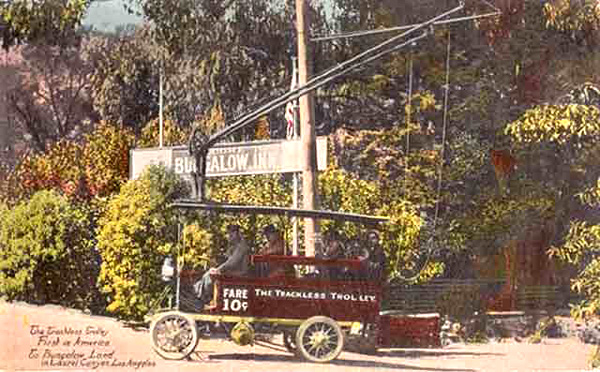LAUREL CANYON—Nowadays we call it Lookout Mountain, sometimes we add the “Avenue” part if we feel like it. We mean both the street running off Laurel Canyon and the houses south of the road. I recently had the pleasure of reminding the US Government that we actually have a Lookout Mountain Peak. I am told that the name will be noted in official government records. This made me wonder how’d the name get lost anyway?
The LA Times reported that in 1908 a Syndicate bought 250 acres—some reports say it’s 280 acres [0.40 ≥ 0.43 square miles]—of land along the rim of Lookout Mountain. Apparently even in those early days the area had already been named. The acreage along the rim included three separate mountain peaks: Lookout Mountain at 1,250 in elevation; Wonderland Peak, which had been known as Washington Peak, at an elevation of 1,300 feet; and, Wulff’s Peak at 1,350 feet above sea level. I’m determined to hunt for information on who this Wulff was, but that’s another story. The purchase price reported in 1908 by the LA Times is $98,000. The formal buyer was F.B. Yoakum. This might be the same F.B. Yoakum who at the turn of the century was the Chairman of the Executive Committee of the Rock Island Railroad. Yoakum originally hailed from Rock Island Miss., so I guess that made him an “Eastern man.”
The Syndicate’s plan at the time was to build a wagon/automobile road that connected all three peaks. The road was planned to connect to the city’s train service, The Los Angeles Pacific Line, at the base of “Laurel Cañon.” The wagon road was estimated to cost $35,000 to build, and the railroad carried a price tag of $100,000. This was the beginning of the plan for a Scenic Railway that was actually built up Laurel Canyon. The pitchman was a local businessman, A.B. Salisbury.
So how were these men going to raise all this money? In 1914 a group of investors, the LA Times called them “Eastern men,” applied to the Railroad Commission of the State of California seeking to mortgage the 230 acres for $25,000. The financing would be in the form of promissory notes for 10 years at 7 percent interest. The funding seems to have been a common place scheme at the time. The Railroad Commission records indicated that only 230 acres were going to be pledged. The collateral was the contemporary valuation of that acreage of $200,000 and $3,500, which was the value of the accompanying Water Company. The conditions required the Syndicate to clear all the remaining mortgages on the property so that these newly issued notes would be in first position. The Syndicate was granted until June 30, 1915, within which to sell the notes, and report back to the Commission.
Apparently, the LA Times was ahead of the pack with its reporting in 1908, almost nine years before the Wonderland development hit its stride.
That’s how Wonderland got its start. That’s “the how and why” of America’s first Trackless Trolley. It was just the beginning of the development of a unique and always cutting edge community.






